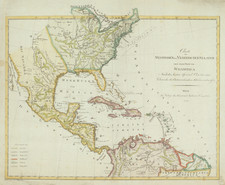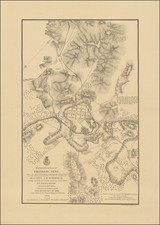The End of the Confederacy in the West
A nice example of this detailed depiction of the battlefield at Franklin, Tennessee, prepared for the United States War Department. Done under the direction of Col. W.E. Merrill, Chief Engineer, from surveys by Major James R. Willet and Major T.J.L. Remmington.
The map includes a remarkably detailed depiction of Union and Confederate troop positions, roads, railroads, buildings, and other landscape features of Franklin, Tennessee, along with excellent topographical details. The map shows the Union's 4th and 23rd Army Corps in their fortified position around Franklin. Opposing the Union line is J.E.B. Stewart's Calvary and Robert E. Lee's Army Corps commanded by Lieutenant General John Bell Hood.
Physical considerations like hills, woods, and roads are illustrated so one can better visualize the battlefield. The fortified, uphill Union position in Franklin is heavily detailed while the Confederate advance through the woods is also shown. The map also takes note of the shifting positions of the cavalry, skirmishers, and battle lines as the fighting progressed.
The Battle of Franklin
As the campaign season of 1864 came to a close, the Confederate States of America desired to make one last push to ease their military situation before the year ended. Earlier in November, Union General William T. Sherman launched his ambitious March to the Sea, which essentially divided the Confederacy in two. In a bid to ease the pressure in Georgia, Lt. Gen. John Bell Hood led the Army of Tennessee in a counter-offensive that sought to destroy Union supply lines in the West and draw military force away from the beleaguered CSA.
In response to Confederate incursions in Tennessee, the Army of Ohio, commanded by Major General John M. Schofield, was dispatched to northern Tennessee. Union forces quickly occupied the town of Franklin and constructed defensive breastworks on the hills outside town. This strategic decision likely saved the army as the next day Hood launched a series of brutal attacks against the Union line.
Despite contrary advice, General Hood launched his attack late in the afternoon and continued attacking as night fell. The battle raged throughout the evening as Confederate forces continuously assailed the Union line with little effect. As night fell and Confederate forces struggled uphill, soldiers engaged in vicious hand-to-hand combat through the woods and nearby properties. The Union line held through the night and inflicted massive casualties on their opponent. The Battle of Franklin would prove to be one of the final nails in the coffin of the Confederate States of America due to the loss of commanding officers and senior troops.
General Hood's defeat at Franklin forced him to retreat to Nashville with a diminished fighting force and a lack of senior officers. The Army of Tennessee would fight one last major battle in December. Again, they lost to Union forces and were forced to abandon Tennessee completely. Hood resigned his command in January and the remnants of his army were ordered to the Carolinas instead. Hood's departure from command and the abandonment of Tennessee spelled an end to the Confederate campaign in the West.
Although not as famous as some eastern battles, the Battle of Franklin was a pivotal moment for both sides in the Civil War. The Union cemented its control of the West which effectively ended any possibility of the Confederacy mounting an invasion north. While there was still some fight left in the CSA, Franklin was a noticeable turning point in the military efficacy of the Southern Army. The defeat as pictured here likely sped up the end of the Civil War. The brutality of the Battle of Franklin underscores what the war had become by this point too. Overall, a niche but a key battle in the history of the American Civil War.









![The United States of America Confirmed By Treaty 1783 [shows Franklinia]](https://storage.googleapis.com/raremaps/img/small/84491.jpg)


![[ Tennessee / Louisiana / Mississippi / Alabama ] Boston Mountains (408) Radar AAF Aeronautical Chart](https://storage.googleapis.com/raremaps/img/small/97161.jpg)

